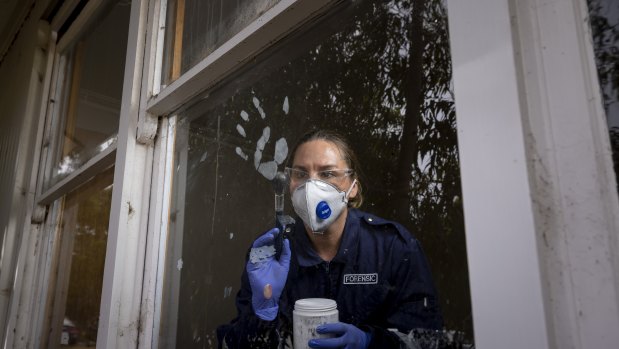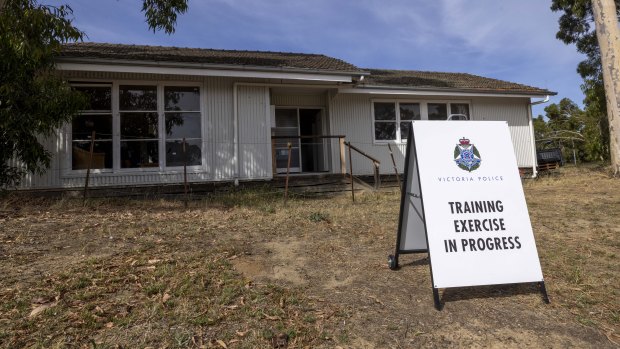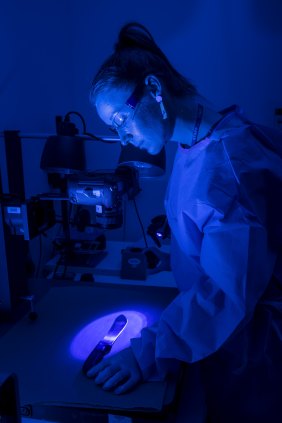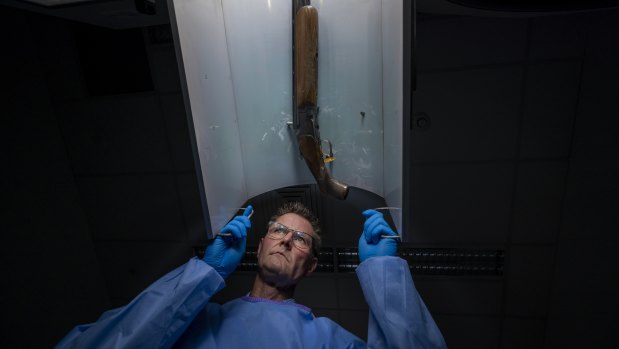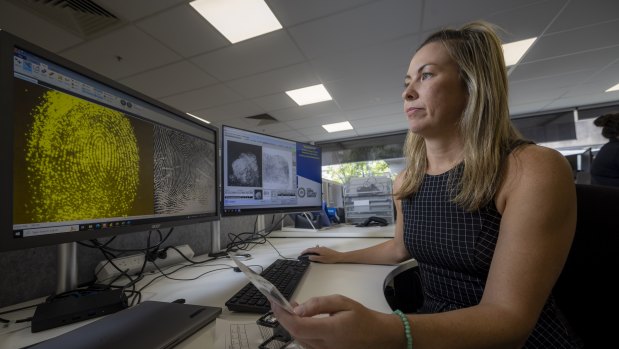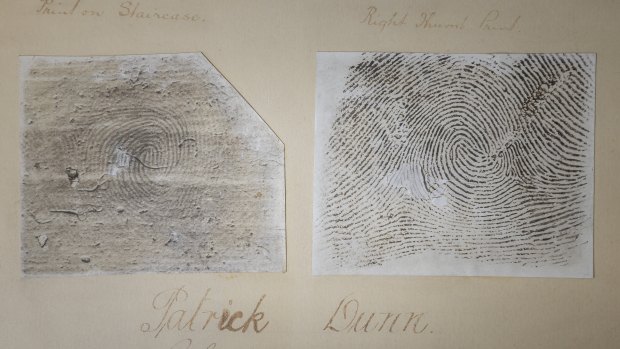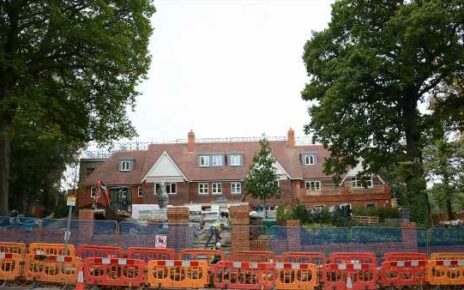Fingerprint specialist Deborah Hughes dusts a full handprint on the interior of a window in a weatherboard house. In this small, slightly ramshackle home, police have investigated thousands of crimes.
The house Hughes is examining isn’t lived in, or frequented by master criminals, or a gang hideout. It’s a training house for Victoria Police’s forensics unit, on the edge of their facility in Melbourne’s north.
Forensic officer Deborah Hughes dusts a window.Credit:Wayne Taylor
There are blood spatters on the walls, secret cavities hiding USBs, a headless dummy lying on a bed with a pool of blood behind it and a dirty mirror that comes off its hinges.
The house has the look of being somewhere between a squat and a share house. Grass grows out of the gutter. Nearby, a car – recently dusted for prints – bakes in the morning sun.
The fingerprint unit is one of Victoria Police’s oldest forensic teams. While technology has moved the field along, the basics haven’t changed considerably.
Fingerprints are still one of the most reliable kinds of forensic evidence, with an accuracy rate of 99.83 per cent, chief forensic scientist Kaye Ballantyne says. Identical twins have the same DNA, but not the same fingerprints.
The forensics unit’s training house in Melbourne’s north.Credit:Wayne Taylor
The print on the window is mine; I put it there the morning of my visit.It is composed of elements that investigators would normally find in a print at a crime scene: sweat, sunscreen and oils present on my hand.
When the unit enters a room at a scene, unit leader Katie Nichol says, they’re thinking of surfaces from which to pull prints. The prints can be fingertips or palms. Last year, the team processed 274 scenes.
Police say they can detect as many as 100 identification features on a single print. Often they’re partial, and among many other non-relevant prints that would cover any home in Melbourne.
Could an enterprising crook analyse the picture, produce a copy of my print, and implicate me in some crime?
“We’re trained for that,” says Ballantyne. She won’t tell me how, not wanting to give their advantage away. “It’s possible to fake a fingerprint in different ways.”
It’s a strange thought, printing a fake hand, planting evidence. But even then, Ballantyne says, the team can still tell the difference.
On May 11, 2020, Abdul Hakim Naurozi, 31, refused to hand over the drugs he was delivering to two Melbourne men in Endeavour Hills, and they threatened to shoot him.
Blake Wynne, armed with a sawn-off shotgun and out of prison just six days, hit Naurozi across the back of the head with the gun when he refused.
Abdul Hakim Naurozi was killed in Endeavour Hills on May 11, 2020.
Wynne’s finger hit the trigger and the gun went off. Naurozi was shot in the face. As part of the investigation, officers recovered a sawn-off shotgun they suspected was linked to Naurozi’s death, and brought it here.
Developing good latent fingerprints off wood is more challenging than a glass bottle or steering wheel. The gun Wynne used to shoot Naurozi had a wooden handle, which didn’t hold a latent print well.
At first, forensic officers treated the gun with vaporised superglue – similar to the stuff you’d find at Bunnings. The process is called cyanoacrylate fuming: superglue is heated to the point that it evaporates and settles on natural oils or sweat that might mark a print.
“It’s quite funny to think of a household item that everybody uses that can do that with humidity and a bit of heat and off you go,” says Tracie Gould, the manager of the fingerprint sciences group. It’s a cheap and effective technique to draw prints, but it doesn’t work as well on porous surfaces such as wood.
Fingerprint expert Bree Harris examines a knife.Credit:Wayne Taylor
Fingerprint examiner Bree Harris, bathed in blue fluorescent light, explains that to get a better print, investigators treated the sawn-off shotgun with a process called vacuum metal deposition.
This works in two parts: first gold is evaporated in a vacuum to form a microscopic layer on the surface being examined. Every time this process is done, examiners use up a small bit of gold, about the size of half a match.
Then they evaporate zinc to form a corresponding layer on the surface, revealing the print. The print ridges are left transparent while the background is painted with a thin layer of zinc.
Police put the print that emerged from the handle of the shotgun into the National Automated Fingerprint Identification System. This matched the print to Wynne, who later pleaded guilty to a murder charge. He was jailed this month for 19 years and seven months.
Forensic officer Craig Hewitson sets a gun in place with a series of magnets.Credit:Wayne Taylor
As of December 2021, the identification system held 4.5 million fingerprints. Last year the team searched 95,923 latent fingerprints on the system – more than 250 per day.
“We have had instances where the same latent has been found at 20 different [crime] scenes,” Nichol said.
“We send those results to the intelligence unit, and they may have other intelligence, whether it be DNA or other pieces of information, that they can use to piece together who this person may be that has been at multiple crime scenes.”
Fingerprint latent unit leader Katie Nichol.Credit:Wayne Taylor
Last year, police analysed 3271 exhibits and identified 8934 separate individuals, though they were not all persons of interest.
Victoria’s forensics unit has just celebrated its 120th year. Over that time, much has changed: the team grew from two original forensic officers to more than 90, the department is now composed primarily of women, and there are more people with master’s degrees wandering the halls.
The practice of using fingerprints for identification dates back thousands of years. Prints have been found on ancient clay tablets and seals, on the walls of Egyptian tombs, and on Minoan, Greek, and Chinese pottery. In China, workers unable to read or write would pick up paychecks with their fingerprint. Chinese authorities would validate government documents with a finger.
The fingerprints of Patrick Dunn linked him to a 1905 tobacco robbery.Credit:Wayne Taylor
Forensic officer Craig Hewitson points out a pair of prints that linked a man named Patrick Dunn to a 1905 tobacco robbery, the first time a Victorian court accepted fingerprint evidence.
Dunn, while nabbing £40 of product – part of a spate of robberies at the time – grasped paint that wasn’t completely dry, and left a small indentation from which police recovered a print.
“It’s not a bad print, pretty good detail in the paint.”
The Morning Edition newsletter is our guide to the day’s most important and interesting stories, analysis and insights. Sign up here.
Most Viewed in National
From our partners
Source: Read Full Article
